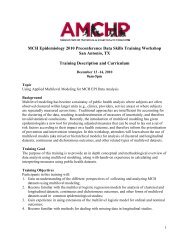Childhood Obesity: The Role of Health Policy - Association of ...
Childhood Obesity: The Role of Health Policy - Association of ...
Childhood Obesity: The Role of Health Policy - Association of ...
You also want an ePaper? Increase the reach of your titles
YUMPU automatically turns print PDFs into web optimized ePapers that Google loves.
site (www.nichq.org). <strong>The</strong> Public <strong>Health</strong> Informatics Institute has been assessing stakeholders’ information<br />
needs in this area as a first step toward developing a blueprint for action (McPhillips-Tangum,<br />
Torghele, Saarlas, Renahan-White, 2006). Clearly, addressing the obesity epidemic requires a new<br />
model <strong>of</strong> care that emphasizes chronic care and uses HIT for better care management and to empower<br />
individuals and families to manage their own health. Such a system also emphasizes the interoperability<br />
<strong>of</strong> systems so that information can be exchanged between public health, schools and other community<br />
settings and healthcare providers. Unfortunately, physicians who care for children are behind most<br />
others in the adoption <strong>of</strong> electronic health records (Kemper, 2005; Menachemi et al., 2006). Registries<br />
could also be useful in identifying and tracking obese children, however, few <strong>of</strong> these exist and most<br />
have not focused on the issue <strong>of</strong> childhood obesity to date.<br />
Demonstrating Program Effectiveness and Sustainability<br />
<strong>Health</strong>care approaches to pediatric obesity are challenged to demonstrate their impact as the research<br />
and evaluations are still emerging. <strong>The</strong> United States Preventive Services Task Force (USPSTF) concluded<br />
in 2005 that “the evidence is insufficient to recommend for or against routine screening for overweight<br />
in children and adolescents as a means to prevent adverse health outcomes.” <strong>The</strong><br />
recommendations from this national expert panel are used extensively by health plans and others to<br />
determine coverage policy and many do not presently cover for screening or counseling to prevent childhood<br />
obesity. In addition, coverage for treatment <strong>of</strong> obese children is highly variable. Many <strong>of</strong> the programs<br />
identified by NICHQ have worked hard to demonstrate their effectiveness to public and private<br />
funding sources. However, there is wide variation in how effectiveness is defined and measured and little<br />
ability to compare across programs and initiatives. <strong>The</strong> 2005 IOM report made a distinction<br />
between “best possible” evidence and “best available” evidence, acknowledging that the absence <strong>of</strong> “best<br />
possible” evidence should not preclude action on the part <strong>of</strong> providers and systems. In this area, some<br />
health plans have decided to go beyond relying on the USPSTF recommendations or other sources <strong>of</strong><br />
“best possible” evidence-based recommendations to develop and/or sponsor an array <strong>of</strong> interventions.<br />
<strong>The</strong>y are also adding to the evidence base on effective interventions by evaluating weight management<br />
programs that they have either sponsored (e.g.,<br />
Highmark, Inc.), or developed (e.g., Blue Cross Blue<br />
Shield <strong>of</strong> North Carolina, Empire Blue Cross, or<br />
<strong>Health</strong>Partners). Most recently, in late 2007, the<br />
AMA released their updated recommendations on<br />
the prevention and management <strong>of</strong> childhood obesity,<br />
recognizing — once again — the need for<br />
health care practitioners to act on the best available<br />
evidence given the magnitude <strong>of</strong> the epidemic.<br />
However, still lacking is evidence on how to take<br />
these recommendations and implement them in a<br />
sustained fashion in various primary care settings.<br />
“We can’t just keep harping on physicians<br />
to change their behavior.<br />
Gathering data on which practice based<br />
interventions make a difference is critical…but<br />
it is a catch-22. You can’t run<br />
programs on thin air; if resources are so<br />
limited, you can’t generate data which<br />
will help you be more effective.”<br />
Nancy Krebs, MD, FAAP.<br />
Barriers and Challenges<br />
Numerous barriers to the appropriate prevention, identification and management <strong>of</strong> childhood obesity<br />
were identified in our review <strong>of</strong> current activities and previous reports. <strong>The</strong>se barriers include individual-level<br />
factors (e.g., family history, cultural issues, awareness and understanding <strong>of</strong> overweight as<br />
a health challenge), organizational factors (e.g., training and education <strong>of</strong> health pr<strong>of</strong>essionals, avail-<br />
8



